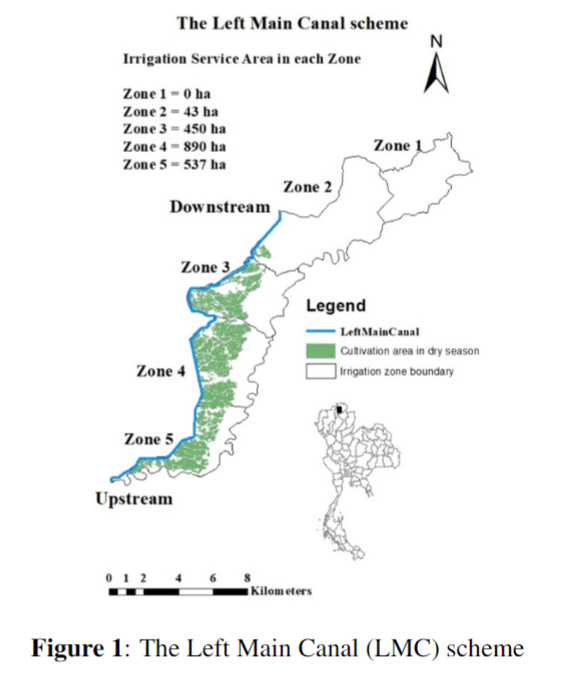Monitoring and Evaluation of Hydraulic Off-Takes Sensitivity in Left Main Canal Scheme in Chiang Rai Province
Main Article Content
Abstract
The study aims to monitoring and evaluation the sensitivity of water flow variation through hydraulic off-take in the Left Main Canal scheme (LMC scheme) dominated on the Mae Lao irrigation scheme (MLIS), Chiang Rai province. Because water scarcity is always a serious problem in the dry season due to over cultivated area, checking irrigation water supply along the main canal level is necessary to monitor equity of water distribution. Selected hydraulic off-takes structures are measured by the off-take sensitivity value. Results found that initial canal section is low sensitivity values (less than 1), while the middle and end of the LMC sections are high sensitivity values (greater than 2). According to the result, hydraulic off-takes management of study area is suggested that the low off-take sensitivity values covers the initial canal sector should only require intermittent gate adjustments, the medium off-take sensitivity values includes some parts of the initial canal section should require average adjustment and frequency maintenance program and the high sensitivity, including almost all structures located from the middle to the end of the canal section, should require frequent adjustments, calibrations, and maintenance program before dry season.
Article Details

This work is licensed under a Creative Commons Attribution-NonCommercial-NoDerivatives 4.0 International License.
References
References
Burton, M.A., Irrigation Management: Principles and Practices, Wallingford: CABI, UK, 2010.
Cavestro, L., Participatory Rural Appraisal (PRA): Concepts Methodologies and Techniques, Universita Degli Studi Di Padova Facolta’ Di Agraria, Italy, 2003.
FAO., Modernizing Irrigation Management: The Masscote Approach Mapping System and Services for Canal Operation Techniques, Irrigation and Drainage Paper No. 63, Food and Agriculture Organization of United Nations, Rome, 2007.
Horst, L., Irrigation Systems. International Report. Agricultural University, Wageningen, Netherlands, 1983.
Kouchakzadeh, S. and Montazar A., Hydraulic Sensitivity Indicators for Canal Operation Assessment. Irrigation and. Drainage Engineering, (2005) 54 (4).
Mahbub, S.I. and Gulati, N.D., Irrigation Outlets. Atma Ram, Delhi, India, 1951.
Mina Sadat Seyedjavad, Mahmoud Mashaal, and Aliasghar Montazar., Evaluation of Hydraulic Sensitivity Indicators for Baffle Modules (Case Study: Varamin Irrigation and Drainage Network), Journal of Hydraulic Structures, 1(2) (2014) 33–43.
Prayoon, Y., Analysis of main infrastructures of hydraulic control in 13th Office of irrigation. The Royal Irrigation Project report. Thailand, (2010), Available from www.kmcenter.rid.go.th/kmc13/km/send/vijai-2012-3.pdf: Accessed date: 3/7/2018.
Renault, D., Aggregated Sensitivity indicators of irrigation systems hydraulic behavior, Agricultural Water Management, 43(2) (2000) 151-157.
Renault, D and. Hemakumara. H.M., Irrigation Off-takes Sensitivity, Journal of Irrigation Drainage Engineering, 125:3 (1999) 131.
RID., Monitoring and Evaluation of Water distribution Plan in Weekly Manual. Working Manual No. 10. Royal Irrigation Department. Thailand, 2010.
RID., Flow Rate Calculation Manual. Working Manual No. 13, Royal Irrigation Department. Thailand, 2010.
RID., Water Level and Hydraulic Structure Manual. Working Manual No. 14. Royal Irrigation Department. Thailand, 2010.
Shahrokhnia, M., Javan, A.M., and Shahrokhnia. M., Influence of lateral canal water depth on off-take and cross regulator discharge. Irrigation and Drainage, 58(5): (2009) 561-568.
Wongtragoon U, Kubo N, Tanji H., Performance diagnosis of Mae Lao Irrigation Scheme in Thailand. (I) Development of unsteady irrigation water distribution and consumption model. Paddy Water Environ, 8(1) (2009) 1–13.


